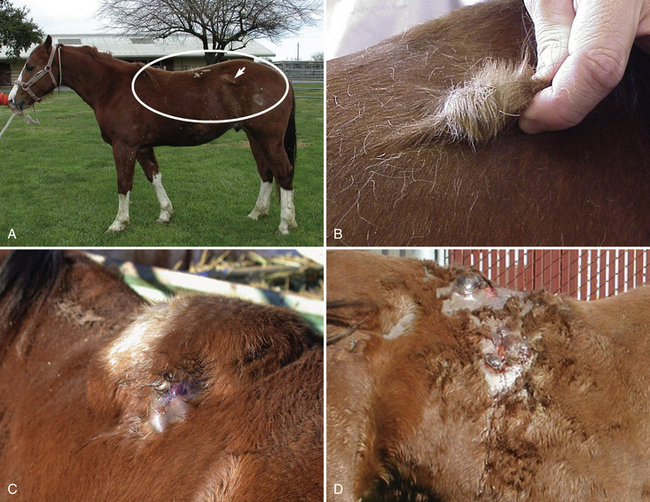CHAPTER 154 Hereditary Equine Regional Dermal Asthenia
Hereditary equine regional dermal asthenia (HERDA) or hyperelastosis cutis is an inherited skin disorder seen predominantly in the American Quarter Horse breed. It has also been seen in breeds that share bloodlines with the American Quarter Horse, including American Paint horses and Appaloosas. The disease first manifests in young horses. Previous reports suggested an association between first saddling and the onset of clinical signs; however this may be related to maturation of the skin that corresponds to the age at which horses are broken to ride. Although inherited disorders are often thought to be congenital (present at birth), this is not always the case. There are many examples in other species of adult-onset inherited disorders. In horses specifically, inherited disorders are not as easily recognized, especially ones that do not appear as congenital diseases, because of the nature of horse reproduction. Foals are rarely born as twins, and full siblings are relatively uncommon. The genetic basis of a disease is difficult to distinguish from a birth defect unless full siblings are affected with the same problem. Most of the currently recognized inherited disorders in horses have been established based on breed predispositions to a disease recognized over a relatively long period. HERDA is just such an example. Initial reports of the disease occurred about 30 years ago. Over the course of the last 10 years, we have collected enough data to establish that the disease is inherited and to identify the location of the gene responsible for the disease.
CLINICAL PRESENTATION
Based on an evaluation of the medical histories of 50 affected horses the mean and median ages of onset of clinical signs are 1.3 and 1 years, respectively. Horses with HERDA have lesions in an unusual distribution on the body. Lesions are usually seen only along the dorsal aspect of the animal, less commonly on the limbs and not on the ventral aspect. The dorsal distribution of lesions may explain why the association with the saddle was suggested. Interestingly, girth sores have not been reported in horses with HERDA. In one affected stallion, lesions were seen on the dorsal aspect of the penis. The skin in these areas may seem to be easily torn or stretched; however, on closer inspection, the skin is loosely attached to the underlying fascia, creating a crater appearance (Figure 154-1). These areas often develop seromas and hematomas, that is, blisters filled with either serum or blood. Healing per se is usually adequate but often leaves rather unsightly scars. The lesions can range in size from 1 to 20 cm, although in younger horses they seem to be smaller. Whereas individual lesions appear to heal normally over time, the lesions may occur with greater frequency and severity as the horse ages. There are no internal abnormalities or lesions associated with HERDA.




